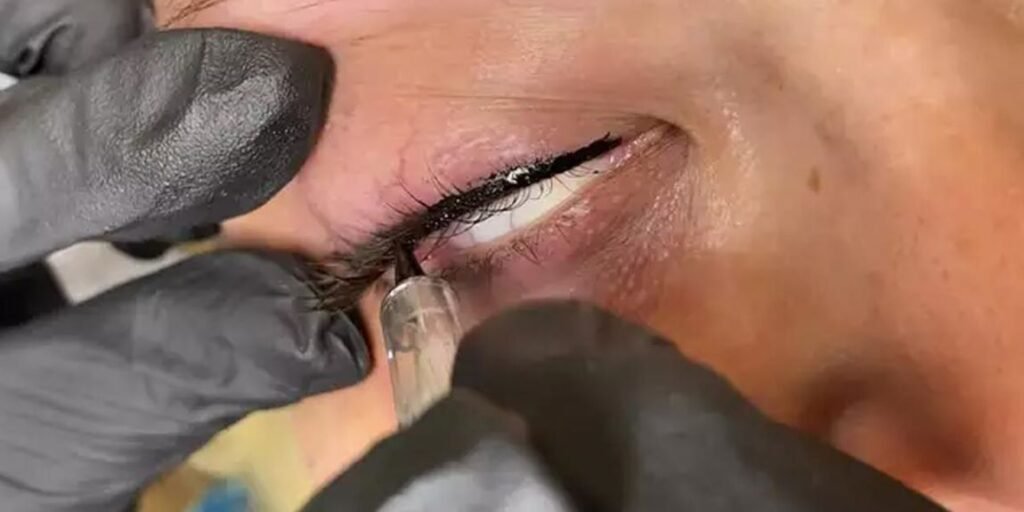Take a look at waterline tattoo before and after photos and you’ll likely be impressed. Models boast sharply defined, jet-black lines tracing their eyes. No smudging, skipping, or unevenness in sight. But before you book your appointment, it’s wise to learn what goes on behind the scenes. As alluring as permanent eyeliner appears, is lining the delicate waterline safe? Or is the procedure too risky for the sake of convenience? Let’s investigate further.
What exactly is a waterline tattoo? It’s essentially a permanent tattoo placed along the inner rims surrounding the eyes. The waterline refers to the moist, sensitive tissue between the eyeball and eyelid. Traditional tattoo artists inject dermal ink to create extremely lasting eyeliner. An alternate semi-permanent option uses cosmetic tattooing to provide defined eyes for around 5 years before fading.
But just because something can be done doesn’t mean it should be. Safety must come before beauty when interfering with vision. So are waterline tattoos worth the hype or hidden hassles? We’ll examine the pros, cons, and precautions regarding one of makeup’s boldest permanent frontiers.
In this article
The Allure of Waterlines
First, let’s address why waterlining has become a coveted trend in the first place. There’s no denying the immediate gratification of waking up already decorated and dazzling. It provides serious convenience for busy bees avoiding the daily grind of mastering tricky eyeliner wings. Even makeup pros tout the time savings and flawless results that waterline tattooing offers. Never smudging or wearing off, the crisp lines withstand everything from humidity to tears without fading.
Plus the transformation waterlined eyes provide is stunning. Models on Instagram lovingly stroke newly enhanced eyes post-procedure. Eyes appear wider, brighter, and irresistibly defined. For those with lackluster thin lashes, it proves especially transformative by creating the illusion of depth and fullness along the lash line. Even semi-permanent options that last around 5 years deliver serious bang for the buck when considering the time invested in arching liner daily.
But at what cost? Let’s examine potential safety hazards that arise when inking one of the most sensitive areas of the face.
The Hidden Dangers of Waterlines
The number one threat waterline tattoos present is infection. Why is this region so vulnerable? The mucous membrane lining waterlines performs vital protective and lubricating functions. But it’s also extremely delicate. Any abrasion invites foreign contaminants inside.

Unfortunately tattooing requires repeatedly piercing skin which inevitably disturbs the eyes’ meticulously balanced ecosystem. Top tattooists sterilize equipment and use sterile disposable needles. However microscopic tears from the dozens of necessary punctures give bacteria access through the mucosa to connective tissues and blood vessels underneath.
Even minute amounts of ink or debris infiltrate quickly, triggering painful swelling and vision changes. Staph infections, if left untreated, can permanently scar sensitive corneal tissues. So while the tattoo gun itself may be sterile, the repeated perforation of the mucous membrane inevitably increases infection likelihood.
And risks continue post-tattoo. Healing skin weeps fluid and plasma until the thousands of microabrasions close up. Each tear represents an open door for infectious invaders during the weeks-long mending process. Touching the eyes to clean or apply ointment introduces more germs eager to set up camp in the warm, moist environment.
Additionally, the body registers tattoo ink as foreign material and tries desperately to expel it. The resulting inflammation generates free radicals which can damage cells and tissues in the delicate eye area. A poorly compromised immune response also generates granulomas or cysts. These bumps distort the ink and cause uneven pigmentation later.
Furthermore, many artists still use lower-quality inks containing carcinogens and allergens banned inside the EU. So along with run-of-the-mill eye infections, metal toxicity and staining can occur from shoddy chemicals. Those with sensitive skin or autoimmune conditions face higher complication risks as well.
So in the end, while waterline tattoos promise enhanced eyes free of liner smudges, it may come at the cost of infection, vision changes, or permanent distortion. Weigh options carefully beforehand.
Aftercare Essentials
Healing from waterline tattoos requires diligent aftercare for proper results and safety. Skipping instructions may exacerbate discomfort or cause poor ink integration requiring fixes later. Expect eyes to swell almost fully shut for 1-2 days before gradually decreasing.
Strictly adhere to artist guidelines but basic rules apply:
• Wash hands thoroughly before gentle eye cleansing to limit germ transfer
• Use sterile saline spray twice daily to gently cleanse eyelids
• Avoid rubbing eyes or exposing to steam, chlorine, direct sun, or scratchy fabrics
• Apply the recommended healing balm daily using clean applicators
• No eye makeup for 4-6 weeks until completely mended
• Expect procedures every 3-5 years for semi-permanent options
Conclusion
Like all seemingly instant beauty transformations, waterline tattooing carries unseen risks beneath the surface alongside perks. Assess personal health factors and alternate designs before pursuing permanent eyeliner procedures. Then vet artists thoroughly. While waterline tats prove problematic for some, choosing reputable experts and aftercare compliance helps avoid regrets down the line.
Ultimately optimize safety, even if it means touching up liners the old-fashioned way. Because nothing looks more stunning than healthy radiant eyes, free of red flags or infections. Prioritize vision wellness first when considering cosmetic eye enhancements. It’s simply not worth potential harm just to wake up perfectly lined. Take the prudent approach and make educated choices if considering waterline tattoos.











